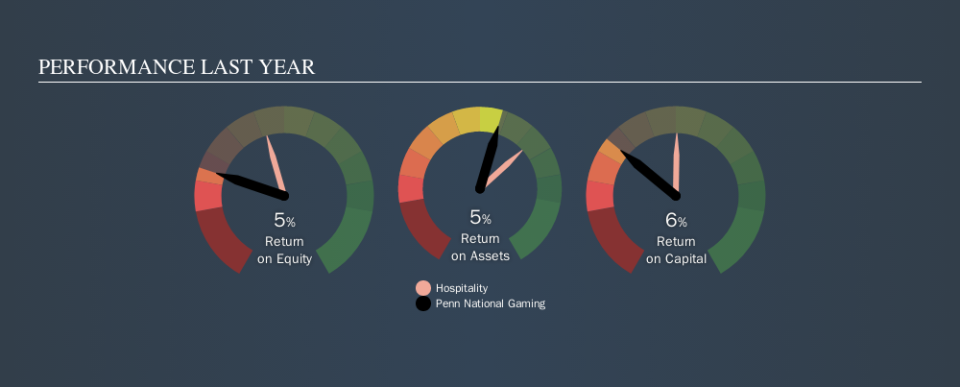Why Penn National Gaming, Inc.’s (NASDAQ:PENN) Use Of Investor Capital Doesn’t Look Great

Today we'll look at Penn National Gaming, Inc. (NASDAQ:PENN) and reflect on its potential as an investment. In particular, we'll consider its Return On Capital Employed (ROCE), as that can give us insight into how profitably the company is able to employ capital in its business.
Firstly, we'll go over how we calculate ROCE. Then we'll compare its ROCE to similar companies. Then we'll determine how its current liabilities are affecting its ROCE.
Understanding Return On Capital Employed (ROCE)
ROCE is a measure of a company's yearly pre-tax profit (its return), relative to the capital employed in the business. In general, businesses with a higher ROCE are usually better quality. Overall, it is a valuable metric that has its flaws. Author Edwin Whiting says to be careful when comparing the ROCE of different businesses, since 'No two businesses are exactly alike.'
So, How Do We Calculate ROCE?
The formula for calculating the return on capital employed is:
Return on Capital Employed = Earnings Before Interest and Tax (EBIT) ÷ (Total Assets - Current Liabilities)
Or for Penn National Gaming:
0.06 = US$795m ÷ (US$14b - US$861m) (Based on the trailing twelve months to June 2019.)
So, Penn National Gaming has an ROCE of 6.0%.
See our latest analysis for Penn National Gaming
Is Penn National Gaming's ROCE Good?
When making comparisons between similar businesses, investors may find ROCE useful. Using our data, Penn National Gaming's ROCE appears to be significantly below the 9.1% average in the Hospitality industry. This could be seen as a negative, as it suggests some competitors may be employing their capital more efficiently. Separate from how Penn National Gaming stacks up against its industry, its ROCE in absolute terms is mediocre; relative to the returns on government bonds. Readers may find more attractive investment prospects elsewhere.
Penn National Gaming's current ROCE of 6.0% is lower than its ROCE in the past, which was 12%, 3 years ago. Therefore we wonder if the company is facing new headwinds. You can see in the image below how Penn National Gaming's ROCE compares to its industry. Click to see more on past growth.
When considering this metric, keep in mind that it is backwards looking, and not necessarily predictive. Companies in cyclical industries can be difficult to understand using ROCE, as returns typically look high during boom times, and low during busts. This is because ROCE only looks at one year, instead of considering returns across a whole cycle. Future performance is what matters, and you can see analyst predictions in our free report on analyst forecasts for the company.
What Are Current Liabilities, And How Do They Affect Penn National Gaming's ROCE?
Liabilities, such as supplier bills and bank overdrafts, are referred to as current liabilities if they need to be paid within 12 months. Due to the way ROCE is calculated, a high level of current liabilities makes a company look as though it has less capital employed, and thus can (sometimes unfairly) boost the ROCE. To check the impact of this, we calculate if a company has high current liabilities relative to its total assets.
Penn National Gaming has total assets of US$14b and current liabilities of US$861m. Therefore its current liabilities are equivalent to approximately 6.1% of its total assets. Penn National Gaming reports few current liabilities, which have a negligible impact on its unremarkable ROCE.
What We Can Learn From Penn National Gaming's ROCE
If performance improves, then Penn National Gaming may be an OK investment, especially at the right valuation. Of course, you might also be able to find a better stock than Penn National Gaming. So you may wish to see this free collection of other companies that have grown earnings strongly.
If you like to buy stocks alongside management, then you might just love this free list of companies. (Hint: insiders have been buying them).
We aim to bring you long-term focused research analysis driven by fundamental data. Note that our analysis may not factor in the latest price-sensitive company announcements or qualitative material.
If you spot an error that warrants correction, please contact the editor at editorial-team@simplywallst.com. This article by Simply Wall St is general in nature. It does not constitute a recommendation to buy or sell any stock, and does not take account of your objectives, or your financial situation. Simply Wall St has no position in the stocks mentioned. Thank you for reading.

 Yahoo Finance
Yahoo Finance 
